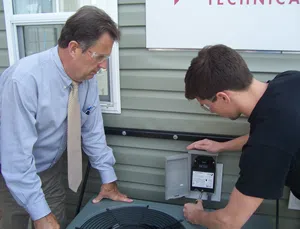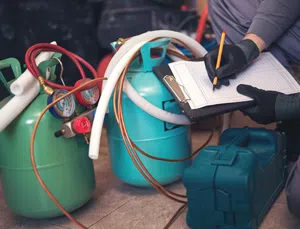A skilled workforce begins and ends with the contractor.
Throughout the HVACR industry, contractors are struggling to fill open positions with qualified individuals. In many instances, job applicants lack the skills necessary for success as an HVACR service technician and request top dollar.
Since most jobs in the industry are with smaller companies, it’s often (incorrectly) concluded that the employment gap is a direct result of the inability of smaller contractors to compete with the larger companies with regards to salary and benefits.
The Mechanical Service Contractors of America (MSCA), whose members offer some of the most sought offer jobs in the industry, also struggles to fill positions. This is a clear indicator that this is an industry-wide problem.
The MSCA surveyed member companies to find out their hiring needs. The initial survey revealed that 85 percent of their members need to hire between one and five technicians within the next year.
Interpreting projected growth numbers, taking into account the inevitable retirement of their workforce, MSCA members discovered that 87 percent of their members will need as many as 15 technicians within the next five years, and 63 percent need to hire and train as many as 30 technicians within the next 10 years.
The HVACR industry’s employment problem is going to become even more of a challenge to overcome as 40 million Baby Boomers retire, and Generation Z has more career options than previous generations.
Getting Generation Z Interested
When asking a group of contractors, “Whose job it is to go to high schools and recruit future technicians for the HVACR industry?” the overwhelming response indicated that it is the responsibility of the HVACR instructors at community colleges and trade schools.
Based solely on this response, the job of recruiting the next generation of HVACR service technicians falls upon the roughly 1,000 HVACR programs at community colleges and trade schools.
There are numerous problems with this scenario. Most HVACR programs have one full time instructor, who runs a day program, a night program or, in many cases, both. Many schools hire adjunct instructors who have full-time day jobs and teach classes in the evening. In both scenarios, there is little, if any, time to go out and recruit.
Even if each and every instructor could free up one full day a week, they’d still have the overwhelming task of visiting more than 37,000 high schools in the United States.
A frequent complaint is how difficult it is to get people into our industry. The schools point to the contractors, while the contractors point right back to the schools. The truth of the matter is that the recruiting of technicians into the HVACR industry is the responsibility of everyone involved in the HVACR industry, including contractors.
Contractors can easily get involved in the process by participating in Program Advisory Committee meetings and educating the public about the exciting opportunities in the HVACR industry.
Visit High Schools
Contractors know what they want in an entry-level technician. No one knows more about your business and the type of employees you want than you. Teachers are not on the front line, you are. Nobody can convey your thoughts and ideas to potential employees better than you!
By visiting schools, you can share your HVACR success story, while debunking many of the myths that surround the trades.
As long as we can remember, parents and guidance counselors have been telling students that they need a college degree in order to become successful in life. Being armed with reliable data will help the truth come out.
The United States Department of Labor, Bureau of Labor Statistics (BLS) tracks more than 700 occupations in 300 industries, and publishes detailed reports that can be used to effectively speak about what it truly takes to be successful. For example, the BLS analysis of jobs in the United States shows that 20 percent of jobs require a bachelor’s degree or higher.
This means that 80 percent do not! In addition, 67 percent of jobs require a post-secondary technical (HVACR, welding, plumbing) education, obtained from a community college, trade school or apprenticeship program.
The BLS estimates, over the next 10 years there will be a 14 percent increase in employment in the 700 occupations they track. During that same time, the HVACR industry will grow by 34 percent and 31 percent of the HVACR workforce will retire.
Two thirds of the people working in the HVACR industry 10 years from now will be people not in the industry today. In addition, unlike many other jobs, HVACR service jobs cannot be outsourced.
Join a Program Advisory Committee
HVACR programs are required to hold periodic program advisory committee (PAC) meetings, where contractors and other industry professionals are asked to review the program and provide feedback.
The ultimate goal of having industry professionals review the program’s courses, training manuals, tools, test instruments, tool kits, equipment and trainers is to help the program produce a product (the graduates) that will best serve the needs of the customer (the contractor).
A well-run PAC meeting enables contractors to suggest changes that can help them strengthen their business by creating a more qualified team of technicians. It also allows contractors to see the brands of equipment, tools and test instruments used in the program.
To help ensure graduates are better prepared to work on the brands the contractor services, they may also consider donating equipment to the school.
It’s no secret contractors have lots to juggle in their busy schedule, but those who participate in PAC meetings can see potential technicians in action and evaluate their inherent talent, temperament and work ethic while still in school.
Through participation, contractors have a front row seat to see if students are a good fit for their organization.
When diamonds-in-the-rough are discovered, many employers hire them before they become available on the open market, often even before graduation.
In addition, participating in internship or apprenticeship programs provides another opportunity to see their talents in action, prior to employment.
Educate Through Non-Traditional Means
Take a minute and ask anyone in the HVACR industry how they got started. There’s a good chance they had a friend or relative who recruited them.
Now, take a minute and think back about the automotive and electronics industry.
Most boys growing up opened the hood of their car, or took a radio apart, however, it’s doubtful any child asked their grandmother if they could go into the basement to inspect the furnace.
The HVACR industry is at a recruitment disadvantage, so we must find unique and non-traditional ways to recruit new blood.
One such example would be having the HVACR program host an event that offers food and fun activities run by the PAC members.
As a result of the event, potential students are brought into an HVACR lab where they may have otherwise never had visited.
This is a golden opportunity for contractors and other industry partners to sell potential future technicians on the opportunities that await them in this industry.
Another idea would be to judge at a First Lego League (FLL) tournament, or host it at the HVACR program you’re affiliated with. FLL is where middle school children build robots that use motors, gears and sensors to accomplish various tasks.
To complete the tasks, they make decisions on gear ratios and number of motors needed, use color and sound sensors and, most importantly, they need to critically think through problems to achieve their goals.
Watch just one of these tournaments and you’ll want to recruit these students to become technicians.
This is a long-term plan, but its non-traditional and one cannot do the same thing and expect a different result.
Friends, Family and Neighbors
Word of mouth has always been the best (and least expensive) form of advertising. But who said that the advertising has to come from others? Throughout the course of the day, we all interact with friends, family, neighbors and people working in many different fields.
All HVACR contractors have great stories to tell about our industry, so why not share them? We know our industry is a great industry to be in, but we all need to tell others how great it is too!
Many people have jobs where they go to the same office, see the same people and do the same things each and every day. For many, this is fine. For others, seeing the same people and doing the same things day-in, day-out would drive them crazy.
The life of an HVACR technician is quite different. Imagine traveling to new places multiple times a day, meeting new people every day and encountering unique challenges on a daily basis.
Our industry has so many exceptional opportunities for the right people, so it’s important for us to reach out to as many people as possible and spread the word.
To truly fix a problem to your satisfaction, you must be part of the solution. This includes recruiting the next generation of HVACR technicians. Middle and high school students need to know they can secure a lucrative career in one of the fastest growing fields that cannot be exported or automated, and can pay just as much as, if not more, than most jobs requiring a four-year degree.





